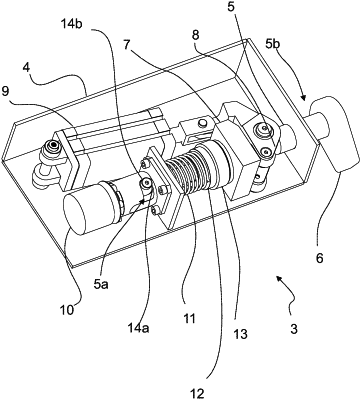| CPC F16L 23/036 (2013.01) [F16L 37/124 (2013.01)] | 19 Claims |

|
1. A pipe flange coupling device for coupling a first pipe flange to a second pipe flange, comprising:
a frame attachable in connection with a first pipe of the first pipe flange;
a spindle, having:
a longitudinal axis running substantially parallel with the first pipe of the first pipe flange on a radial outside of the first pipe flange as seen along the longitudinal direction, when in use;
a proximal end;
a distal end extending longitudinally over the first pipe flange, when in use,
a pawl fixed to the distal end of the spindle and radially extending therefrom,
wherein the spindle being arranged as:
radially confined with respect to the frame;
axially movable along the longitudinal axis with respect to the frame between an extended position and a retracted position, and
rotatably movable about the longitudinal axis with respect to the frame between a inwardly rotated position, in which the pawl overlaps with the first pipe flange, as seen along the longitudinal direction when in use, and an outwardly rotated position in which the pawl does not overlap with the first pipe flange as seen along the longitudinal direction when in use,
a rotation arrangement coupled to the spindle so as to selectively rotate the spindle between the inwardly rotated position and the outwardly rotated position;
a translation arrangement coupled to the spindle so as to selectively move the spindle between an extended position and a retracted position thereof, wherein the translation arrangement has an open position and a mechanically restricted closed position, such that movement from the open position to the closed position causes the spindle to move from the extended position to the retracted position, and
the translation arrangement is associated with a biasing member for biasing the translation arrangement into the closed position, wherein the translation arrangement and the associated biasing member being configured such that
during a transition from the open position to the closed position, subsequent to the spindle reaching the retracted position, the translation arrangement first works against the biasing member before reaching the closed position, whereby rebound of the biasing member subsequently biases the translation arrangement towards the closed position, and
during a transition from the closed position to the open position, prior to the spindle departing the retracted position, the translation arrangement works against the biasing member so as to reach the open position;
wherein, the translation arrangement being further configured such that, in the closed position, a force exerted on the spindle towards the extended position causes the translation arrangement to exert a force against the mechanically restricted closed position, thereby preventing the spindle from moving towards the extended position.
|